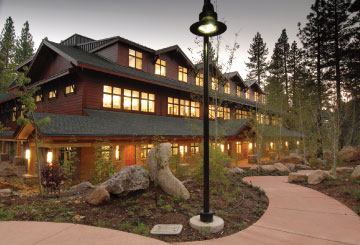Volume 24 · Number 2 · Winter 2007

(Photo: Chris Talbot)
Green Building for a Blue Lake
There's a new heart of learning and discovery in the Tahoe Basin. It's a science lab, hands-on public museum and college classroom. And it's as Earth-friendly as a building can be.
Forty years ago, Lake Tahoe was turning green. UC Davis researcher Charles Goldman was studying how to keep it blue, working in a makeshift lab in Tahoe City—“doing world-class research in a third-world facility.” For decades—as the scientific corps grew and understanding of the lake’s living systems became more sophisticated—the UC Davis lab where it all began remained the same.
No more. In October, a new $24 million Tahoe Center for Environmental Sciences was unveiled on the Sierra Nevada College campus at Incline Village, Nev. The center is a collaboration of the college, UC Davis, the University of Nevada, Reno, and the Desert Research Institute. Here state-of-the-art laboratories and conference rooms will allow scientists and public employees to make and share discoveries as they chart the course of the Tahoe Basin’s long-term health and well being.
From the outset, planners of the new Tahoe center insisted that a building dedicated to environmental science be built on sound environmental principles. The facility is expected to use half the energy of a conventionally designed laboratory and office building and includes a number of “green” innovations.
The Tahoe center is the result of the generosity of individual, corporate and foundation donors who contributed more than
$13 million in private support to UC Davis. That funding—combined with state and federal taxpayer dollars and other funds raised by project partners—enabled construction of the new center, as well as renovation of the old lab facility.
“We embarked on this campaign because we believe Tahoe is one of the world’s great environmental treasures,” said UC Davis Chancellor Larry Vanderhoef. “And we succeeded because so many other people shared that belief.”
The major public space in the new building was supported by $2 million from the Thomas J. Long Foundation. A discovery museum, named the Thomas J. Long Foundation Education Center, offers elementary school groups and other visitors hands-on exhibits planned with local residents and schoolteachers. They can learn from a video “virtual researcher” aboard a simulated Lake Tahoe research boat and inside a simulated laboratory. They can measure water clarity, see how sediment and algae affect the lake, and “fly” over the Lake Tahoe Basin and even the lake’s underwater valleys and mountains.
On the second floor, students from Sierra Nevada College, Nevada’s only nonprofit liberal-arts college, will study environmental science. On the third floor, scientists in the UC Davis Tahoe Environmental Research Center will collaborate with counterparts from UNR and DRI, expanding the landmark studies that Goldman, now the UC Davis Distinguished Professor of Limnology, began so many years ago.
For more information, see Tahoe Basin's New Heart of Environmental Discovery Opens.
The building is open to the public on weekdays from 9 a.m. to 5 p.m., with more public hours to be added soon.
